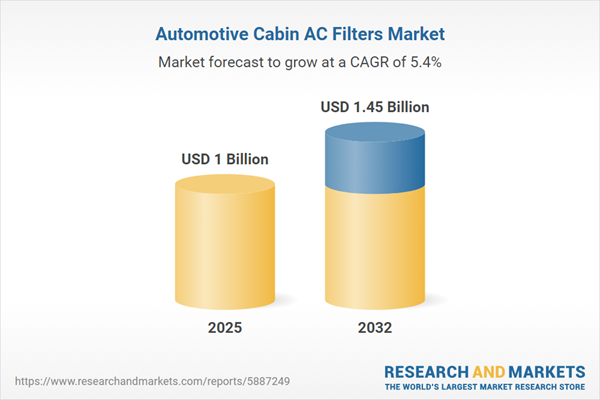Speak directly to the analyst to clarify any post sales queries you may have.
Amid evolving regulations and surging focus on occupant wellbeing, the Automotive Cabin AC Filters Market demands that senior executives prioritize proactive strategies balancing compliance with innovation. An agile approach can translate market complexities into new opportunities for sustained growth.
Market Snapshot: Automotive Cabin AC Filters Market Trends and Outlook
The Automotive Cabin AC Filters Market reached a value of USD 954.19 million in 2024, with projections for USD 1.00 billion in 2025 and a compound annual growth rate (CAGR) of 5.41%. Senior leaders will note that global air quality requirements are rapidly increasing expectations for high-efficiency filtration solutions. Cutting-edge advancements in material science, such as innovative filter media, are enabling manufacturers to expand capabilities and differentiate offerings. Growing regulatory pressure worldwide is pushing organizations to re-examine procurement practices while optimizing supply chain performance. At the same time, a wave of sustainable business priorities and digitally enabled filtration systems is influencing performance benchmarks and industry direction.
Scope & Segmentation of the Automotive Cabin AC Filters Market
- Filter Types: Activated carbon filters deliver strong protection against gaseous pollutants and odors. HEPA filters target and remove ultrafine airborne particulates, elevating in-cabin air quality. Paper and polyester-based variants form baseline solutions adaptable for a broad spectrum of vehicle types.
- Vehicle Types: Commercial vehicle platforms value longevity and rugged filtration, addressing demands for operational resilience. Passenger vehicles emphasize enhancements in comfort and air purity, with solutions tailored to end-user health expectations.
- Application: Both OEM-integrated systems and aftermarket replacements play central roles, each supporting compliance, technical standards, and market accessibility through multi-tier supplier and distributor frameworks.
- Distribution Channels: Products are accessible via authorized retailers, dealership partners, e-commerce offerings, and direct relationships with manufacturer-certified entities, aligning with diverse procurement workflows in the industry.
- Sales Channels: Options include retail storefronts, specialized automotive service providers, business-to-business (B2B) e-commerce platforms, and dedicated online vendors, enabling rapid adaptation to evolving customer and partner expectations.
- Regional Coverage: Operations span the Americas, Europe, Middle East and Africa, and Asia-Pacific. Each region brings nuances in policy and consumer behavior, with particularly fast evolution in major Asian markets as organizations respond swiftly to local regulatory and market changes.
- Company Coverage: Industry leadership is driven by organizations such as MANN+HUMMEL GmbH, Donaldson Company Inc., MAHLE GmbH, Denso Corporation, Freudenberg & Co. KG, Parker Hannifin Corporation, Cummins Inc., Ahlstrom-Munksjö Oyj, 3M Company, and Hengst SE, offering global reach with deep, localized expertise in filtration technology.
Key Takeaways for Senior Executives
- Advanced filtration solutions support compliance with new regulations while bolstering vehicle occupant safety and health initiatives.
- Collaboration between filter producers and electronics specialists enables integrated diagnostics, continuous in-cabin air quality monitoring, and predictive maintenance strategies for fleets.
- Customization of both products and operational tactics to fit local environmental mandates strengthens regulatory alignment, market differentiation, and long-term customer relationships.
- Embracing recyclable or bio-based filter materials aligns organizations with sustainability targets, reinforces stakeholder trust, and prepares them for emerging eco-compliance standards.
- Adopting omnichannel models that blend digital and physical supply paths ensures flexibility and rapid response in volatile commercial environments.
Tariff Impact: Navigating 2025 U.S. Trade Developments
- U.S. tariffs on imported automotive cabin air filters are prompting manufacturers to reassess their production strategies and prioritize nearshore or domestic operations for business continuity.
- Broadening supplier relationships and renegotiating contracts are proven approaches to cost control and safeguarding steady product supply amid adapting trade conditions.
- Leveraging advanced data analytics within procurement and pricing functions supports more reliable forecasting and minimizes risk during market disruptions.
Methodology & Data Sources
This analysis draws on published industry research, regulatory and technical datasets, and direct interviews with sector experts. Scenario modeling and procurement analytics underpin the guidance to ensure actionable clarity for executive decisions.
Why This Report Matters to Decision-Makers
- Enables business leaders to refine product and distribution strategies while proactively adapting sourcing models in dynamic regulatory climates.
- Offers frameworks for mitigating operational risks through adoption of advanced technology and anticipating supply chain disruptions globally.
- Equips executives with reliable insights to build resilient, adaptable supply chains and foster sustainable, scalable growth.
Conclusion
Long-term success in the Automotive Cabin AC Filters Market requires constant alignment with regulatory and technological evolution. Informed leaders will enhance readiness for market shifts and emerging operational risks.
Additional Product Information:
- Purchase of this report includes 1 year online access with quarterly updates.
- This report can be updated on request. Please contact our Customer Experience team using the Ask a Question widget on our website.
Table of Contents
3. Executive Summary
4. Market Overview
7. Cumulative Impact of Artificial Intelligence 2025
Companies Mentioned
The companies profiled in this Automotive Cabin AC Filters market report include:- MANN+HUMMEL GmbH
- Donaldson Company, Inc.
- MAHLE GmbH
- Denso Corporation
- Freudenberg & Co. KG
- Parker Hannifin Corporation
- Cummins Inc.
- Ahlstrom-Munksjö Oyj
- 3M Company
- Hengst SE
Table Information
| Report Attribute | Details |
|---|---|
| No. of Pages | 188 |
| Published | October 2025 |
| Forecast Period | 2025 - 2032 |
| Estimated Market Value ( USD | $ 1 Billion |
| Forecasted Market Value ( USD | $ 1.45 Billion |
| Compound Annual Growth Rate | 5.4% |
| Regions Covered | Global |
| No. of Companies Mentioned | 11 |









